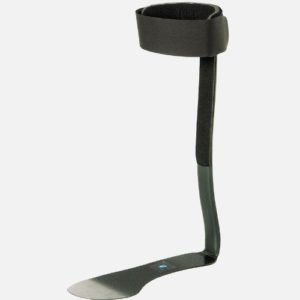What is Foot drop?
Foot drop, in some cases called drop foot, is a general term for trouble lifting the forward portion of the foot. Assuming you have foot drop, the front of your foot could delay the ground when you walk. It is defined as an inability to raise one’s foot at the ankle in a normal position due to weakness in the muscles surrounding the ankle. The weakness can also occur when pushing the dorsiflexor forward as well as raising it. The weakness can be temporary but also can be permanent depending on the underline condition causing the weakness. If the weakness is caused by a myopathy of the ankle muscles then most likely the patient will not recover full range of motion for the foot. Foot drop isn’t an infection. Rather, foot drop is an indication of a fundamental neurological, strong or physical issue.
If you are suffering from foot drop from any number of conditions, then you need a carbon fiber AFO.
In some cases foot drop is impermanent, however it very well may be extremely durable. In the event that you have foot drop, you could have to wear a support on your lower leg and foot to stand firm on your foot in a typical situation.
Foot drop makes it hard to lift the forward portion of your foot, so it could delay the floor when you walk. This can make you raise your thigh when you stroll, like climbing steps (steppage walk), to assist your foot with clearing the floor. This uncommon stride could make you smack your foot down onto the floor with each step. At times, the skin on the highest point of your foot and toes feels numb.
Contingent upon the reason, foot drop can influence one or the two feet.
Foot drop is brought about by shortcoming or loss of motion of the muscles engaged with lifting the forward portion of the foot.
What is an AFO Brace?
AFO stands for ankle foot orthosis and it is used to treat foot drop. Foot drop is a condition that occurs when the individual is unable to lift their foot in a normal fashion. Instead the foot drags / droops down and can easily be caught on uneven pavement or sidewalks, which can lead to trips or falls. In order to prevent this, the user wears an AFO brace to lift the foot back into the correct and normal position. Individuals who have drop foot, require a lower leg orthosis in order to lift their foot while walking.
If left untreated, foot drop can lead to chronic pain in the hip due to a condition known as hip hiking. This occurs when the user tried to compensate for being unable to lift the foot properly by lifting the hip instead. Since the hip is not meant to be used in this manner, light to moderate pain can occur from this improper use.
If you are unable to have insurance cover the price of the AFO, then I would recommend the following:
I have personally used this orthotic device and it is great for treading light to mild foot drop.
Preventing Falls
Since individuals who have foot drop cannot raise their ankle in a normal range of motion, it is imperative to take the necessary steps to prevent falling and the possibility of further injuries. In order to make changes to your house, one should make sure that any walking space is clear of items or other clutter that can catch the foot when walking. Specifically, you will want to remove any kind of cord, wire, toys, or other items that can cause tripping and falling. It is also wise to use glow-in-the-dark tape on any kind of surface that is raised. For example, in my bathroom, there is a small step about 2 in from the living room to the bathroom. I have purchased this tiny ramp and also used the glow-in-the-dark tape on the ramp so that it is impossible for me to trip.
Do You Need to Wear Your AFO All Day?
Regardless of what condition you are in, you will no doubt need to wear your AFO practically constantly. Its motivation is to assist you with mending, so the more you wear it, the sooner you will feel improved. Your orthotist will let you know when and for how long to wear your AFO, so ensure you heed their guidance. It is ordinary to feel awkward from the start, yet there is a change plan that you ought to follow for the initial a few days. Right from the start, wear it for about 60 minutes. On the subsequent day, add one more hour probably. On the third day, you ought to have the option to wear it serenely for around 3-4 hours. Every day from that point forward, you can add an hour until you are wearing it serenely day in and day out. You can definitely relax assuming that you notice red imprints on the skin. That is additionally totally typical. Similarly as you are breaking in the support, your skin is additionally becoming accustomed to the plastic. The redness ought to vanish when you eliminate the support. Yet, assuming rankles begin showing up, make certain to reach out to your orthotist.
